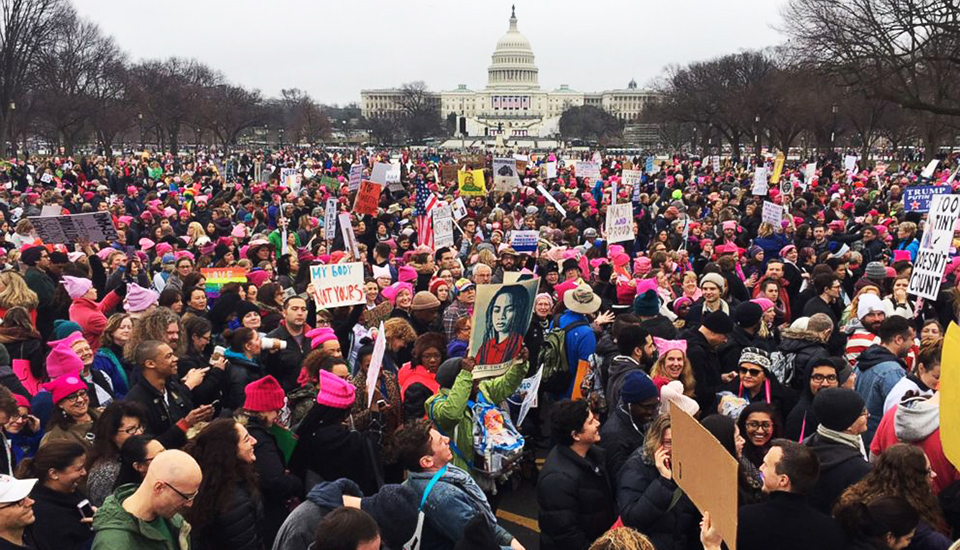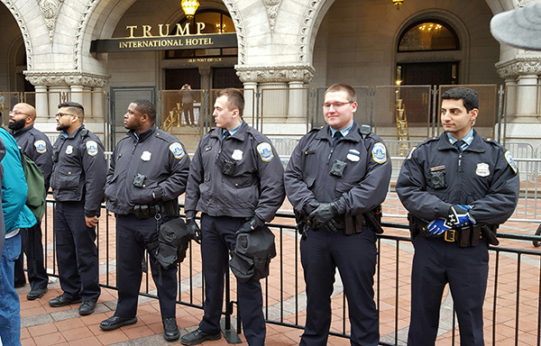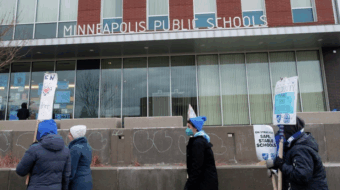
WASHINGTON – At the women’s rights march here Saturday, I heard people from across the country say they were awed and inspired by seeing for themselves they are not alone in wanting to resist the Trump Administration’s onslaught on progress.
Many said they were gaining the energy they needed to build a movement back home.
Close to 60 speakers addressed the crowd from a stage in front of the National Museum of the American Indian. Along with women’s rights activists there were representatives from a broad range of progressive movements, including labor leaders, advocates for civil rights and immigrant rights, healthcare activists, environmentalists and fighters for LGBTQ and Native American equality. There were also spokespersons from many faith communities, actors and actresses, filmmakers, performers of all types, political leaders and elected officials.
Each one stressed the need for united action among all movements.
The march platform stated: “We believe Gender Justice is Racial Justice is Economic Justice.”
The audience roared when Angela Davis said, “The next 1,459 days of the Trump administration will be 1,459 days of resistance: resistance on the ground, resistance in the classrooms, resistance on the job, resistance in our art and in our music,” and resistance at the ballot box.
The crowd was so dense there were times when you could not move and so large there was nowhere to move to; every street and sidewalk in downtown D.C. was jammed.
But people didn’t jostle or panic. Instead, we held each other up.
The DC police went out of their way to be helpful and supportive. Those assigned to guard Trump’s hotel on Pennsylvania Avenue made clear to demonstrators they thought this was a shameful duty. They let demonstrators put anti-Trump signs on the police barricades.

March participants said they felt buoyed by their numbers, especially when compared to the low turnout the day before for Donald’s Trump inauguration.
I’ve taken part in demonstrations in DC for 60 years and it looked to me like there were over a million people in this one.
Strangers talked to each other like old friends.
Jammed together in the crush, Sally from Georgia told me “This is great! I now feel part of America. I came here because I felt alone, like the only one who thinks Trump is a disaster. Now I think I have the guts to get some of my neighbors together.”
There were people of all races, ages, genders and ethnic groups.
The vast majority of signs were handmade and ranged from “Trump has pissed off grandpa” to one carried by a child on his mother’s shoulders saying “I’m five years old and even I know better.”
All day people told me they felt they were participating in the birth of a nationwide fight back movement.
I felt that way, too. It was the same as I felt in 1963 at the March on Washington for Jobs and Freedom, made famous by the speech given by the Rev. Martin Luther King.
The four co-chairs of the demonstration on Saturday were Linda Sarsour, the executive director of the Arab American Association of New York; Tamika Mallory, a political organizer and former executive director of the National Action Network; Carmen Perez, an executive director of the political action group The Gathering for Justice; and fashion designer Bob Bland, who created the “Nasty Woman” T-Shirts after Donald Trump pinned that label on Hillary Clinton.
Honorary co-chairs were Gloria Steinem, Harry Belafonte, LaDonna Harris, Angela Davis and Dolores Huerta.
March participants said they admired these leaders but that they were looking forward to working in their communities to protect and expand the rights Trump is trampling upon.
“We have to learn from the tea party movement,” a woman from Lansing, Michigan said. “They just got together and raised hell.” She added that a few weeks ago she went to indivisbleguide.com to get ideas about forming a neighborhood group, which in one week swelled from eight to 100 people.
Donald Trump tried to divert media attention away from the demonstration by speaking to the employees of the CIA. But he seemed unable to stop himself from engaging in a whose-is-bigger contest. He said his inaugural was larger than the Washington march. Later, White House Press Secretary Sean Spicer repeated this at a press conference.
Trump’s ploy did not work. The march here and those around the world were so huge he was not able to knock them out of the headlines.
Furthermore, the media published photos of how small the crowd was at Trump’s swearing in.
This, too, bolstered march participants’ sense of empowerment.
“[This march] is a networking event,” said Patty from New London, Connecticut.
Many people shared their contact information with one another.
AFL-CIO Secretary-Treasurer Liz Shuler said, “We’re here not only to march, but we’re here to build a movement.”
As one march participant put it, “the fight back is being born right here. Right now.”
Colby Wagenbach contributed to this article.










